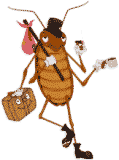Congo-Crimean Hemorrhagic Fever Virus
" You donít want to conga with this virus"
Description: A member of the Bunyaviridae family, this virus is single stranded, negative sense RNA with a segmented three part genome. Its capsid morphology is helical and the virus is enveloped. Replication is speedy, mainly due to its ambisense coding capacity.
Power: Case-fatality rates range from 5-50% depending on the availability of modern medical care. Death usually occurs during the second week of illness, preceded by hemorrhages, shock, and renal failure. It is important to note that a significant number of individuals in some endemic areas have antibodies to CCHF, thus suggesting that many human infections are inapparent.
Attacks: Congo-Crimean hemorrhagic fever is transmitted through ticks from the genus Hyalomma. The virus has a variable host range. Usually, tick larvae and nymphs parasitize birds and small animals, whereas adult ticks attack larger animals like cattle. The virus is transmitted to humans through tick bites or through direct contact with infected animals or their tissues. CCHf can also be transmitted from person to person nosocomially, for example, to surgeons stemming internal hemorrhage.
Outcome: CCHF begins abruptly with fever, headaches, and severe back and abdominal pain. It progresses to extensive hemorrhages from almost any body site. Most cases show signs of hepatitis, with juandice, heptomegaly, and elevated serum levels of liver enzymes. Blood loss form internal bleeding leads to shock, pulmonary edema, and death.
Speed: The incubation period is estimated to be between 3 and 6 days with abrupt onset of acute febrile illness. Initially, patients present severe influenza-like symptoms. Hemorrhagic manifestations occur usually after several days of infection.
Vaccines: There is currently only a mouse brain-derived vaccine, but a much safer one is needed.
Prevention: Taking tick control measures in domestic animals, spraying camp sites and limited areas with acaricides, and using bug repellant, especially when traveling to endemic areas like the Sahara, during spring and summer, can significantly reduce the incidence of Congo-Crimean hemorrhagic fever. Strict isolation of patients, as well as careful handling of blood and vomitus of infected patients, can help control nosocomial spread.
Treatment: Surgical stemming of internal hemorrhage and blood transfusion.
Game Action
You forgot your bug repellant to the Sahara. Lose a turn for at risk exposure to CCHF.

